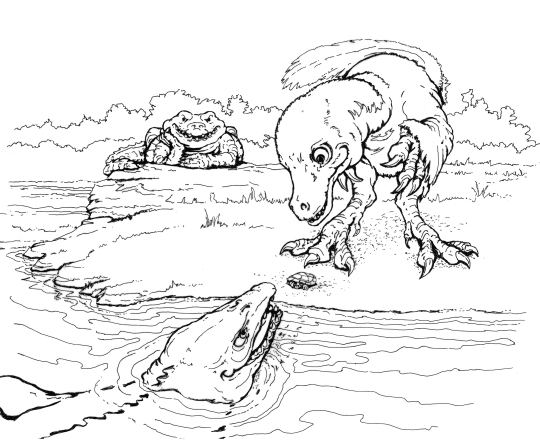![Top: The fossilized poop preserving the baby turtle shell impression.
Bottom: The fossilized poop whitened (i.e., coated with sublimed ammonium chloride to improve contrast). The arrows show the direction that the poop stretched its way through the cloaca of the predator. (In vertebrates [except mammals], the cloaca is the common opening at the end of the digestive tract through which both excretory and genital products are released).](./images/22546-index.jpg) Top: The fossilized poop preserving the baby turtle shell impression.
Top: The fossilized poop preserving the baby turtle shell impression.
Bottom: The fossilized poop whitened (i.e., coated with sublimed ammonium chloride to improve contrast). The arrows show the direction that the poop stretched its way through the cloaca of the predator. (In vertebrates [except mammals], the cloaca is the common opening at the end of the digestive tract through which both excretory and genital products are released).
SOLOMONS, Md. (January 02, 2018)—A baby turtle shell was found for the first time ever in fossilized poop. The Calvert Marine Museum announces the publication of a scientific paper documenting this find which was authored by Stephen J. Godfrey, the museum's Curator of Paleontology, Robert E. Weems, and Billy Palmer and published in Ichnos, a scientific journal dedicated to the study of trace fossils.
During their analysis of the specimen, the authors determined that a predator swallowed a 2 1/2 inch-long whole baby turtle 60—70 million years ago in South Carolina. Remarkably, the shell passed through the digestive system of the animal intact, and apparently the feces fossilized shortly thereafter, preserving an impression of the turtle's shell. The predator may have been either a mosasaur (an aquatic marine reptile from the time of dinosaurs) or a meat-eating dinosaur or bird. This is the first time a body impression of a vertebrate animal has been preserved in a coprolite.
Based on the texture of the fossilized shell impression, the tiny turtle lived for a few weeks after it hatched and before it was eaten. Embryonic turtle shell texture is different from hatchling shell texture. As turtles age, new growth occurs around the perimeter of the embryonic scutes, so it is very easy to distinguish between embryonic and hatchling turtle shell texture. In this unique fossil, the surface texture of the scutes is preserved, including its finely pitted embryonic texture and a narrow perimeter of hatchling scute texture.
There are two main groups of turtles. Those that retract their necks into their shells (the Cryptodires) and those that turn their necks to the side of their shell (the Pleurodires). We know from the pattern of the scutes on the shell that this turtle was a Pleurodire; a side-neck turtle. Modern pleurodires live only in the Southern Hemisphere, but were present in North America during the Cretaceous period and Paleocene epoch.
Two tyrannosauroids—Appalachiosaurus montgomeriensis and Dryptosaurus aquilunguis are known from Late Cretaceous eastern North America. The bird-mimic dinosaurs, the Ornithomimids, were also apparently there during that time and certainly could have also eaten the turtle. A crocodile is not ruled out as the predator, although it is much less likely as the high acid content in their stomach almost always dissolves bone, and consequently would leave no bony shell to be voided to make an impression.
To read the entire article in Ichnos, visit www.tandfonline.com/doi/full/10.1080/10420940.2017.1386662 .
 The three most likely predators that could have swallowed the baby side-necked turtle completely: an aquatic mosasaur (lower left foreground), a terrestrial meat-eating dinosaur (right), or less likely, a crocodile (contemplating the scene from a distance). Illustration by Tim Scheirer, (c) Calvert Marine Museum.
The three most likely predators that could have swallowed the baby side-necked turtle completely: an aquatic mosasaur (lower left foreground), a terrestrial meat-eating dinosaur (right), or less likely, a crocodile (contemplating the scene from a distance). Illustration by Tim Scheirer, (c) Calvert Marine Museum.

